Creating forms
In this article
Introduction to forms
Adding a form
Adding form items
Other form-building options
Managing forms
Introduction to forms
Forms enable you to collect data for a wide range of purposes. Whether it's a questionnaire to solicit interest in volunteering, creating an Internship application form or a parental consent form for a youth group trip, Forms provide all the tools you need to collect responses.
Forms can be created in the Address Book and Children modules, with form response data collected through a form page - the form page URL can be shared with potential respondents, perhaps by embedding the form page link in a website or sharing the form page link in your communications or on social media. In addition to public forms - where anyone with the form page URL can submit a response - you can also send invitations to a selected audience for a private form (the form only accepts responses from invitees) and, where form fields are smart-linked to fields of personal details in ChurchSuite, the invitee's existing details are pre-populated into their form. Where response anonymity is needed, you can create anonymous forms that keep the respondent's identity hidden from module users.
When building forms, you can optionally smart link the fields on the form to the fields in ChurchSuite, meaning that smart-linked field responses in a form can be used to add or update the respondent's data in ChurchSuite. Imagine the following scenarios...
Lindsey is in your Address Book and has been sent an invitation for an 'Update your contact details' form. Their form opens with their existing smart-linked contact details pre-populated into the form. Lindsey uses the form to update their mobile number and email address and submits the form. The church receives Lindsey's response in ChurchSuite, which shows the smart-linked response data is different from the details currently held by the church. A module user can update Lindsey's contact details to match the latest details supplied on the form.
Luke hasn't yet formally connected with the church but following a recent announcement. they have found your 'Join a team' form on the website. The form contains smart-linked fields for name and basic contact details, meaning that when their response is received, a module user can add Luke as a new contact to the Address Book, with the smart-linked form responses used to populate Luke's new profile without requiring a user to manually re-key all the form details
Smart links are incredibly powerful, enabling you to dynamically map fields on a form to the related fields within your ChurchSuite modules.
You can also define form Actions, which can be set to run automatically, conditionally or manually when a form response is received. Actions enable you to take each respondent through your various administrative processes - perhaps assigning tags and key dates, adding notes, adding people into flows, sending preset communications or adding people to small groups and ministries. Forms with actions help ensure nobody falls through the cracks of a busy office! Importantly, designated form Managers are notified when a response is received.
To help get you started we've provided some Example forms that you can install in a module. These examples can be used as a starting point for further customisation or use them simply to help visualise and familiarise yourself with how forms work.
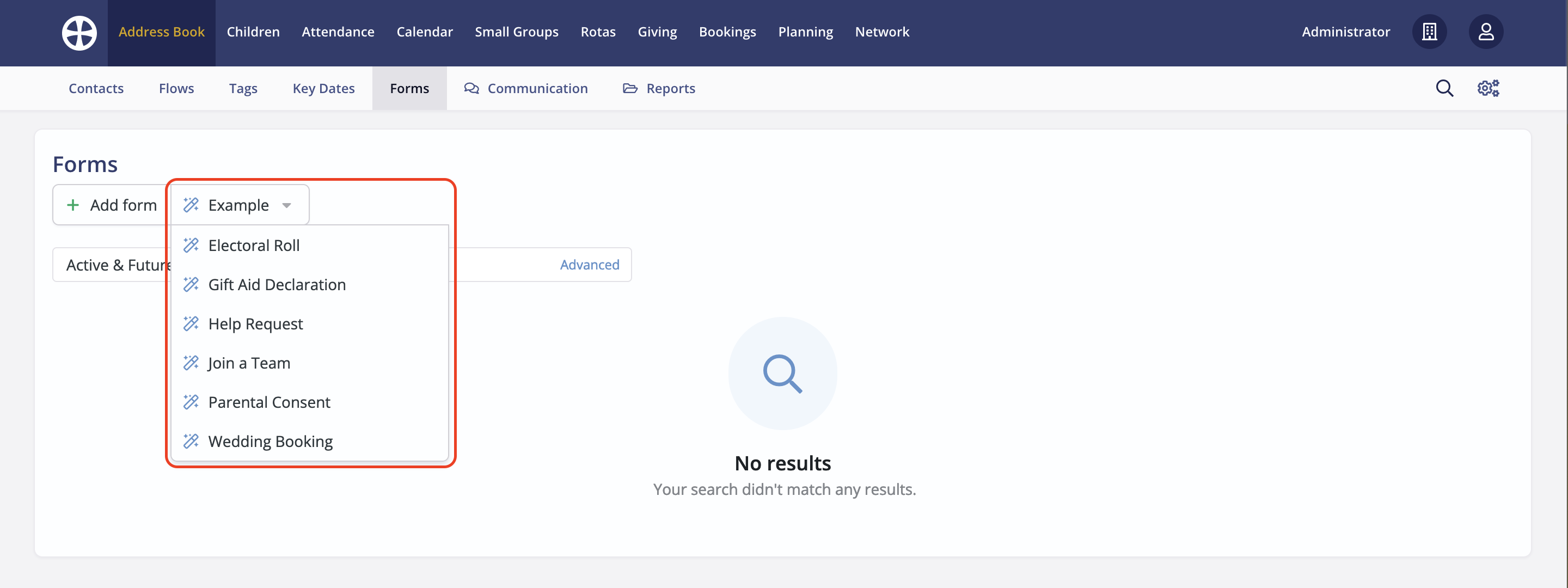
This article explains how to add a form and add fields and other form elements but note the related support articles with further information on:
- sending form invitations
- sharing forms (including embedding forms in a website)
- processing form actions
- managing form responses
Adding a form
Navigate into the Forms section of the appropriate module - the Address Book, where a contact is the primary subject of a form response, or the Children module, where a child is the primary subject of a form response. Click Add form.
Note: Forms for parents/carers are typically added in the Children module so that parents/carers can submit a form response for each of their children, allowing each form response to be linked against each of their respective children's profiles.

On the Add form pop-up (see next image), give the form a suitable Name and optionally specify the Start and End dates within which responses can be submitted. Optionally assign a custom Brand to the form - see the related support article on Using Brands. The form and its responses will be visible to all module users but you can optionally restrict who the form and responses are Visible to. Choose which module/s the form is Visible in and the Primary Response Type - consider the primary subject of the form and, if contacts and children will respond, select both modules and People. Finally, choose the form Access needed for your use case (see below). Multi-site customers can choose a form Site, enabling users to have site-specific forms or "All sites" forms.
- Public forms accept responses from anyone who visits the form page. Responses can be linked to existing people in ChurchSuite (with intuitive linking suggestions provided) but you can also add new contacts and children for an unmatched response, making public forms ideal where respondents may not yet exist in your ChurchSuite modules
- Private forms only accept responses from those who have received a form invitation you've sent. Private forms are therefore only suitable where all the respondents already exist in ChurchSuite. Where the form contains smart-linked fields (explained later), the invitee's existing smart-linked personal details are pre-populated into their private form and responses can be used to optionally update their details in ChurchSuite
- Anonymous forms only permit responses from those to whom you've sent an invitation. While the invite workflow allows you to stay on top of who has and hasn't responded, responses received are anonymous. Anonymous forms are suitable for anonymous voting, surveys and questionnaires where the respondent's identity doesn't need to be known. Anonymous forms that have responses cannot be later edited to make them Public or Private, preserving the anonymity of the invitees and their responses already received
Choosing a Primary Response Type...
When setting up a form, you'll need to specify the main 'type' of person that will be responding to the form - that could be Contacts, Children or both. This will define which Smart Linked fields are available when creating your forms, who you will be able to send form invitations to and which actions are available when managing the form responses you collect. For example:
A Contact Form must be visible in the Address Book module but may also be visible in the Children module; contact-specific fields will be available to be Smart Linked alongside generic person fields. It's only possible to invite Contacts to this form and you'll only be able to link these form responses to Contacts in the Address Book module or add the respondent as a Contact.
A Children Form must be visible in the Children module but may also be visible in the Address Book module; child-specific fields will be available to be Smart Linked alongside generic person fields. It's only possible to invite Children to complete this form and you'll only be able to link these responses to a Child in the Children module or add the respondent as a Child.
A People Form can be visible in the Address Book, in Children modules or both; however, contact or child-specific fields won't be available to be Smart Linked, only generic person fields. You'll be able to link these responses to either Contacts or Children and add the person as either too. You'll be able to invite either Contacts or Children to complete this form.
Once you've created a form - and depending on the fields you add, the invites you send and the people you link - you may no longer be able to change the Primary Response Type. For example, if you have a form whose primary response type is set to Contacts and have added a field that's smart-linked to the Martial Status field in ChurchSuite, you won't then be able to change the Primary Response Type to Children. Likewise, if you had a form whose Primary Response Type is set to People and have sent form invitations to Children, you won't be able to change the Primary Response Type to Contacts.

Clicking Save adds the new form, ready for you to begin adding response fields and other form items. The new form is added with a Draft status - you will be unable to accept responses until published (see later).

In the next section, we see how to build the form by adding fields and other elements and items.
Adding form items
Fields and other items can only be added (or edited or re-ordered) when the form has a Draft status, which prevents responses from being made while the form is being changed. A published form can be Set as draft from the More actions dropdown...
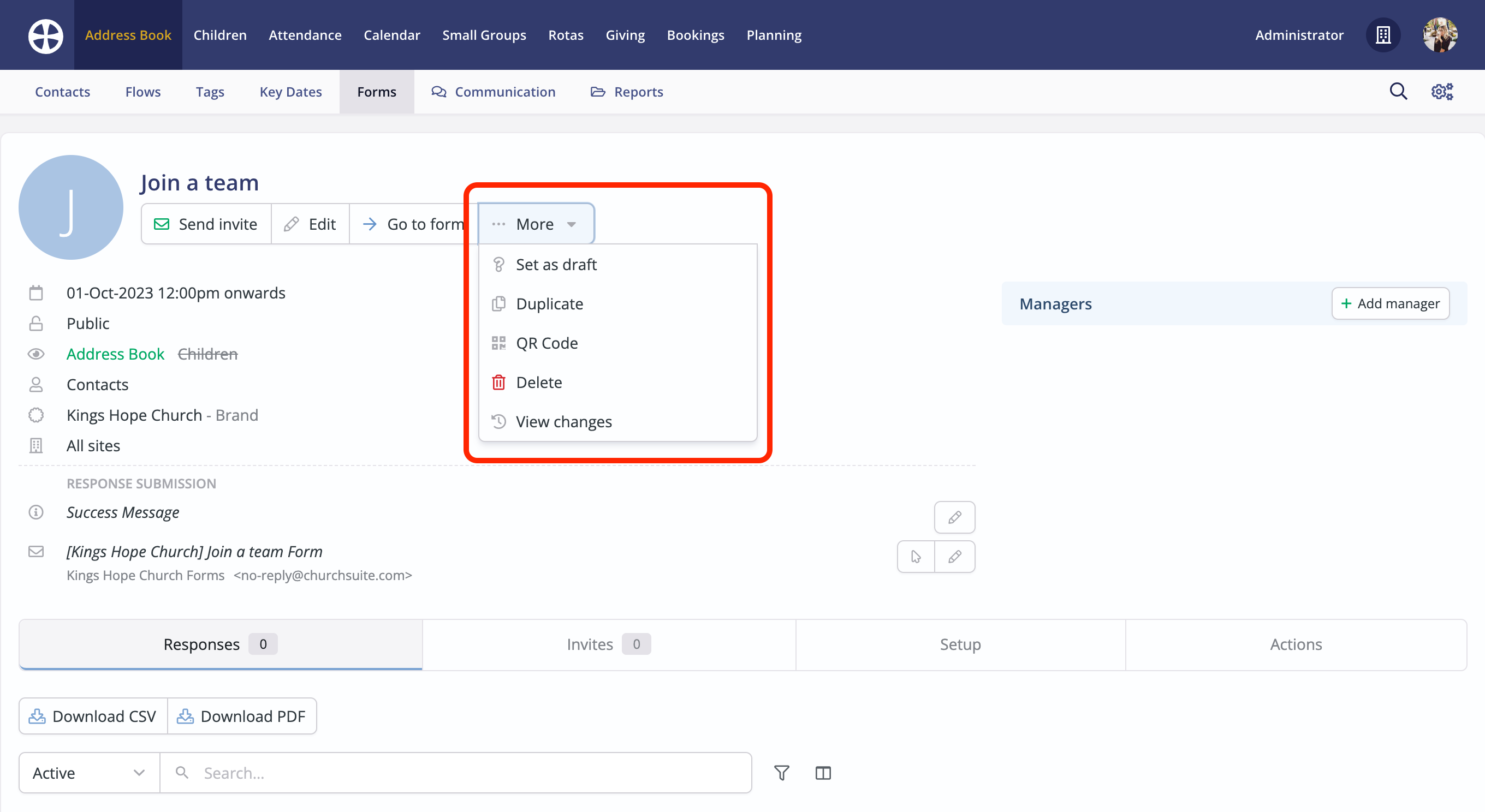
Working from the Setup tab you can begin to add items to the form. You'll be able to further edit and re-order the items you add. There's a wide range of Standard fields and form Elements to choose from. While Contact fields and Contact custom fields are unique to Address Book contacts, and Child fields and Child custom fields are unique to children, some Person fields are common to both contacts and children. The item Search makes field suggestions as you type or you can click Add item and select from a curated list of items.

You can build forms by adding items in any of the following ways - the method you choose will be a personal preference but may be influenced by whether you are working in a browser or app environment and the size of your device screen:
- Double-clicking an item will add it to the end of the form
- Clicking an item's + icon, which surfaces when hovering over the item, will add it to the end of the form
- Dragging an item from the list on the left will allow you to position it between existing items

You can further customise each added item. The options available will depend on the item or field type being added. Let's explore some examples:

In this example, adding a Name field from the Standard fields gives the option to Smart link the form field to a specific field in ChurchSuite - smart-link suggestions are based on the selected field and the module. Smart linking is explained later in this article.

Add the field Name as it is to be shown on the form. Optionally add some Help text to further clarify what you'd like respondents to enter or select and set whether a response is Required. Click Save to add the field item to the form.

The Email field includes a Send confirmation option, allowing you to choose whether the email address entered in this field is the one that will be used to send the response submission confirmation. For example, a parental consent form may have multiple email fields - one for each parent/carer and one for the child. In this way you can control whether the submission confirmation is sent to a parent/carer, all parents/carers or the child - you have lots of flexibility. A further example is when a form is asking the submitter to add another person's email address - perhaps for a reference. In that scenario, you will want a submission confirmation to be sent to the submitter's email address, rather than the referee's email address.

For List-type Standard fields - Radio, Drop-down and Checkbox - you can add response Options.

For a Text element, you have a range of tools to style the content, insert lists and tables, embed links and add images or videos. With a little creativity and imagination, the Heading, Text and Divider elements can help enhance the form response user experience.

Top Tip! Embedding videos in forms
When viewing a video on a site like YouTube, click the "Share" option and select Copy embed code. You can also access this menu option by right-clicking on the video.

Back in ChurchSuite, and having added a Text element to the form, click the ellipses icon to surface the second row of tools and select the <> "source code" tool. Paste the previously copied embed code into the code viewer, being careful to paste it in the right place. Save the code viewer and text element. You can use the Go to form option to preview how the video looks.

The pasted embed code typically includes width and height parameters, which you can adjust (while constraining the proportions), perhaps to fit the full form width of 500px:
<iframe width="894" height="503" src="https://www.youtube.com/embed/fViYK_Xb3Wg" title="YouTube video player" frameborder="0" allow="accelerometer; autoplay; clipboard-write; encrypted-media; gyroscope; picture-in-picture" allowfullscreen></iframe>
The Data Protection element has no settings and is added immediately to the form. The element comprises an affirmative 'accept' checkbox and preset text. See our related support article on How to personalise your ChurchSuite account, which includes a section that explains how to add your data protection statement to ChurchSuite (sometimes referred to as a privacy notice). The article also explains how to customise the additional helper text shown under the 'accept' statement. Depending on data protection legislation for your country/region you may be required to add a data protection element to any form that collects personal data. Respondents are unable to submit the form unless they accept your data protection statement. The statement (or privacy notice) is clickable on forms and will open the full data protection statement to view in a pop-up.

The Signature field is shown on forms as a white box in which a respondent can either use their finger, trackpad or mouse to provide a likeness of their signature. Use of the signature field will likely depend on your processes for verifying a signature and, since the field is a likeness, accurate verification may not be possible and you may be unable to legally rely on a signature likeness. The signature field creates an image that is maintained against the response.

When building a form, the fields and elements available are subject to the following constraints:
- Anonymous forms will not offer any Person fields, Contact fields, Contact custom fields, Child fields or Child custom fields. Only Standard fields (but not smart links) and Elements are available
- Forms not visible in the Address Book will not surface any Contact fields or Contact custom fields
- Forms not visible in the Children module will not surface any Child fields or Child custom fields
- Smart-linked Person fields, Contact fields, Contact custom fields, Child fields or Child custom fields can only be used once and will show disabled in the list if they are already in use on a form. For example, you can't have two smart-linked email fields on the same form - you can only smart link to the one Email address field of a person's profile details
Continue adding fields and elements to build your form. Note the options to drag and re-order items, the icon distinguishing smart-linked items and the item actions to Duplicate, Edit, Delete and View changes.

Top Tip! Handling parent/carer forms and multiple children
There are many scenarios requiring a parent/carer to complete a form on behalf of multiple children. Before building your form, consider the following:
One method is to build one form covering multiple children, perhaps adding several sections of the same questions, one section per child. This method allows the response to be linked to one parent/carer but not to another parent/carer or each child - a form can only be linked to one person. The user experience may also be frustrating - have you added enough sections to cater for larger families? The method also precludes the use of required responses in each section, since a parent/carer may not use all the sections if they only have one or two children. And if the response is linked to a parent/carer, you won't be able to use smart-linked fields to update child details. Further confusion may arise if a parent/carer reuses a form confirmation link from one child to overtype the slightly different details of another of their children, which will change the first response rather than create a new response. This method is discouraged for these reasons.
A better method, offering the most flexibility, best use of functionality and a clear parent/carer user experience is to build a public form in the Children module with fields for only one child and requiring a parent/carer to submit a separate response for each of their children. While this is unavoidably repetitive for a parent/carer with multiple children, it is a process they'll already likely be familiar with for their children's schools. As long as your form is clear and concise, and the completion requests are not too frequent, parents/carers will probably endure the occasional repetitive task of completing the form for each child!
This method means you can use smart-linked child fields on the form so that when a response is linked to a child, the response data will update the child's details, not the parent's/carer's. It means you'll maintain all the child's details - including their historic parental consent forms - against each child, which makes child consent (or the absence of consent) much clearer.
With this method, there are two ways to share the form with parents/carers.
- The first option is to share the form page link in your email communications to parents/carers (perhaps authored from the Children module using the Send to primary parents/carers or Send to all parents/carers option) or make the form available through your website (either embedding the form itself or embedding a link to the form). The email or website page, and the form itself, should ideally provide clear instructions asking parents/carers to submit a form response for each of their children. Responses received can then be linked to the appropriate child in the Children module and any actions or suggested child details changes can be processed.
- The second option is to send form invitations. See the related support article for further information on Sending form invites. However, to track the response status of each child, and pre-populate each child's existing details into a form built with smart-linked fields, the invites must be sent to the child, which will be delivered to the address specified in the Child Email field. It's only possible to surface a child's existing smart-linked details and track that child's invite response if the invite is sent to the child. However, if you add a parent /carer email address to the Child Email field for each invited child in your Children module, you'll be able to deliver the form invitation to the parent/carer email inbox.
You can preview a Draft status form at any time or when a published form has Private access - click Preview form. When you have finished building the form you can Publish it, ready to accept responses.
Should you later need to make form item changes to fields or elements, a published form can be Set as draft. A draft status form cannot accept further responses until it is published again.

Other form-building options
In this section, we look at some further form-building customisation options:
- customising the Success Message people will see when submitting a response
- customising the Submission Confirmation email respondents receive
- assigning form Managers, who will be notified when a form response is submitted
Optionally Edit and add a custom Success Message that shows on the screen when a form response is submitted. This could be a short thank you message but can include embedded links, perhaps to some follow-up resources on your website.
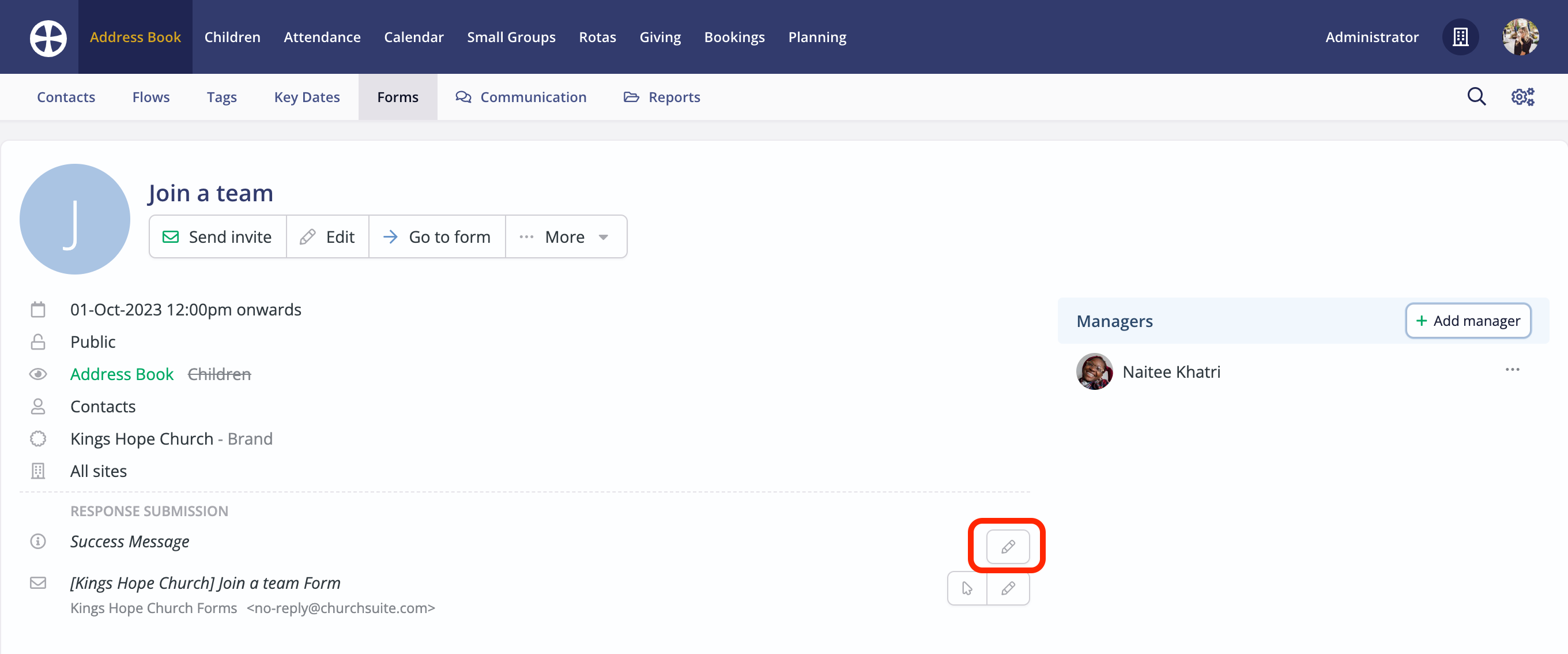
Form respondents will always receive a response Confirmation email when submitting a form response (and if they later make changes to a previously submitted response). Click Edit to add a custom confirmation message...

On the Edit confirmation pop-up, note the options for personalising the email sender details, subject and message. The message field supports 'merge field' personalisation, embedded links and styling. You can also select Include response, which will embed the person's form responses into the confirmation email. Where the response is for a form invite, the sent confirmation is logged against the known respondee's communication log in the Address Book or Children module. However, for public and anonymous forms - where responses are initially received 'unlinked' - the sent confirmation is not logged.
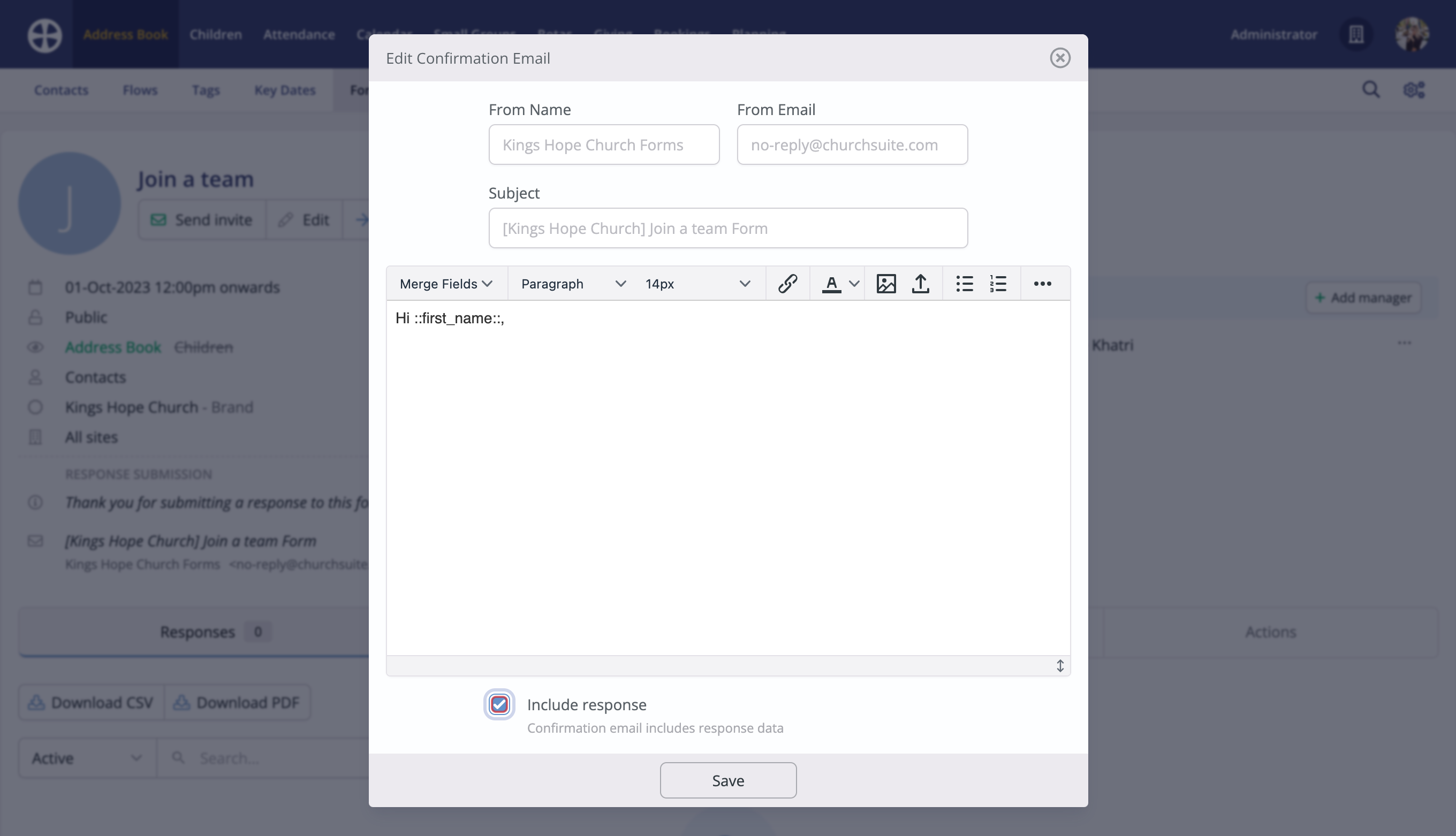
Designated form Managers will receive an email notification each time a new response is first submitted (but not if a previously submitted form response is later changed and re-submitted). The notification email simply communicates that a response has been received - no personal response data is surfaced in the email but Managers with module access can view the full response in ChurchSuite. Click Add manager to search and select an Address Book contact. Multiple managers can be added or, later, removed.
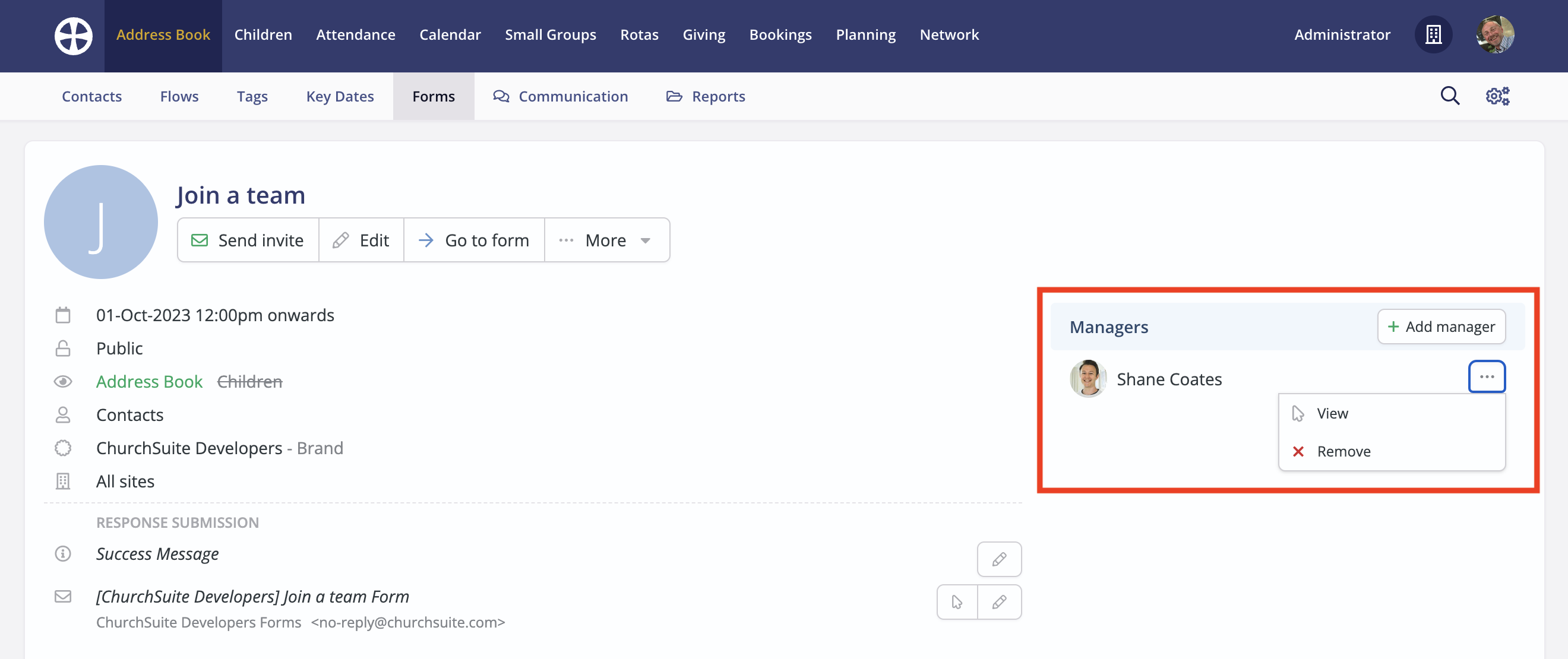
Managing forms
Returning to the Forms section of the module, you can further manage all the forms in the module. You can use the Search and Advanced Search to further filter a long list of forms. The list shows Active & Future forms by default but you can switch to view Past or just Active or Future forms. The list is ordered by form Name but you can optionally order by Responses by clicking on the column heading. Finally, note the form Actions to View, Duplicate, Edit or Delete a form.

Duplicating an existing form will copy all the form's settings, fields and options on the form, smart links, managers, submission confirmation, success message and any actions defined. Invitees and responses are not duplicated, meaning an empty duplicate form will be created.
Deleting a form will also delete all form responses - but not the contacts or children to which the responses may be linked. This action is highly destructive to data and irreversible - so delete it with caution! If a form is no longer needed and no longer collecting responses, consider editing the form and setting the form's End date in the past - the form will no longer be shown in the Active & Future list but the historic responses will be preserved.
